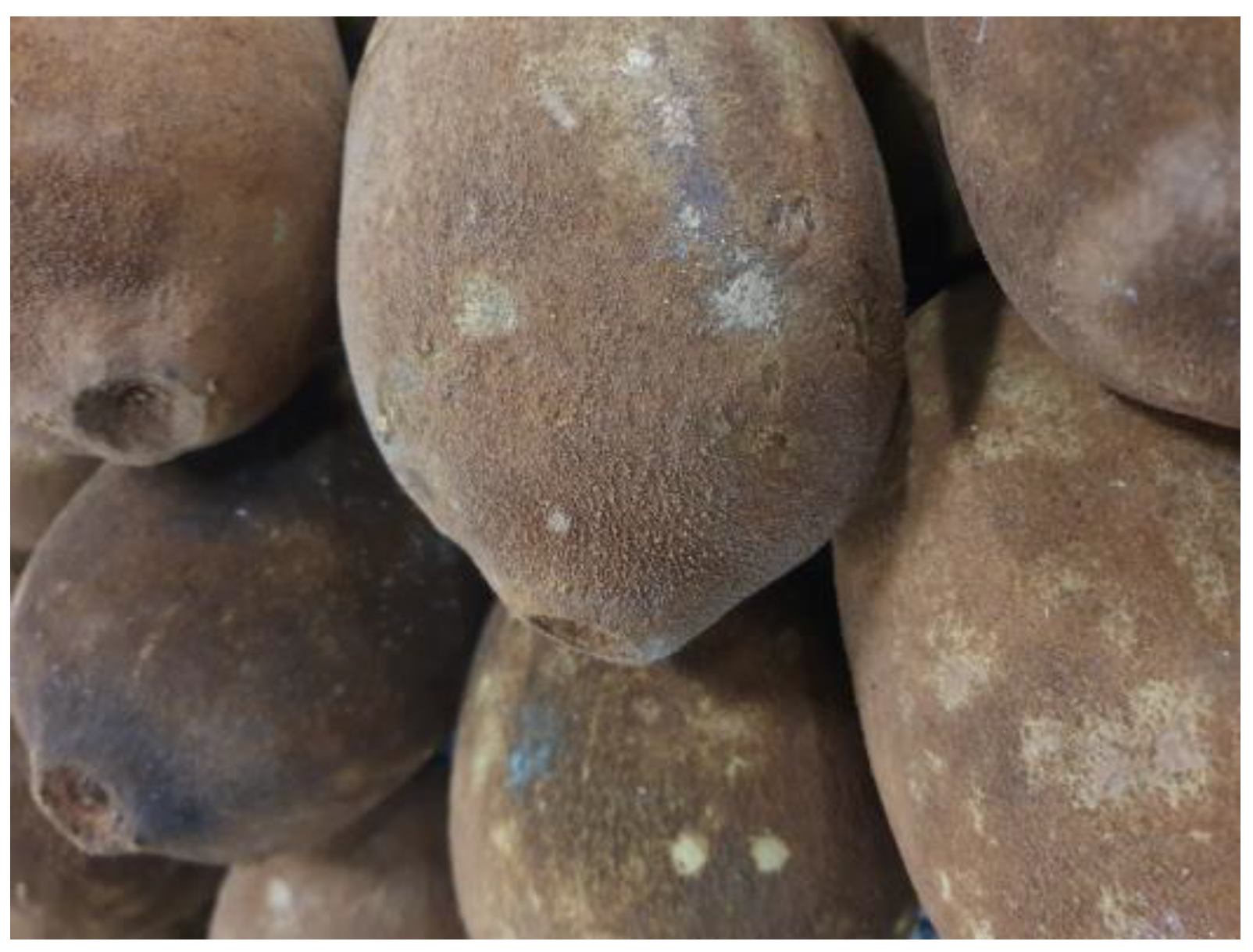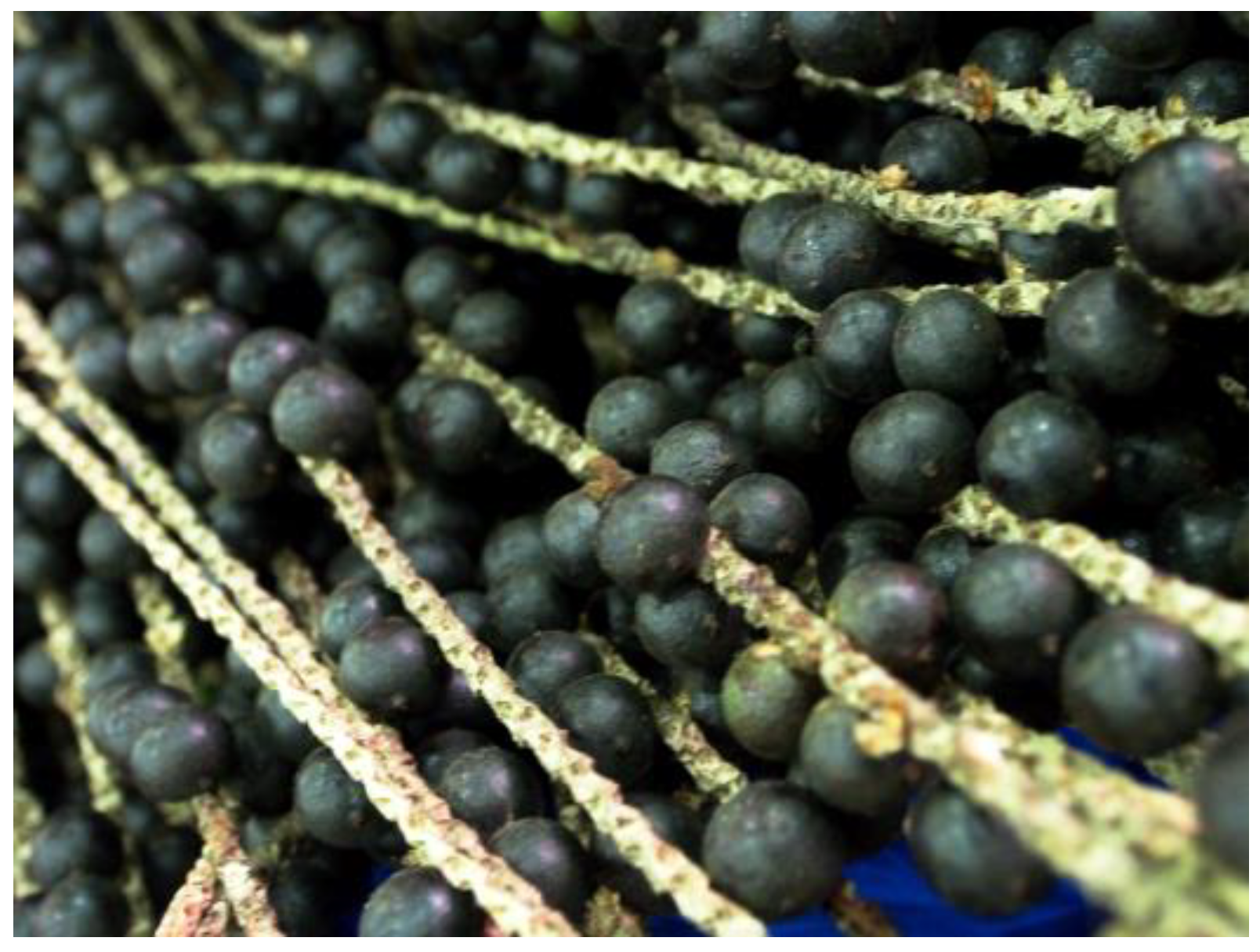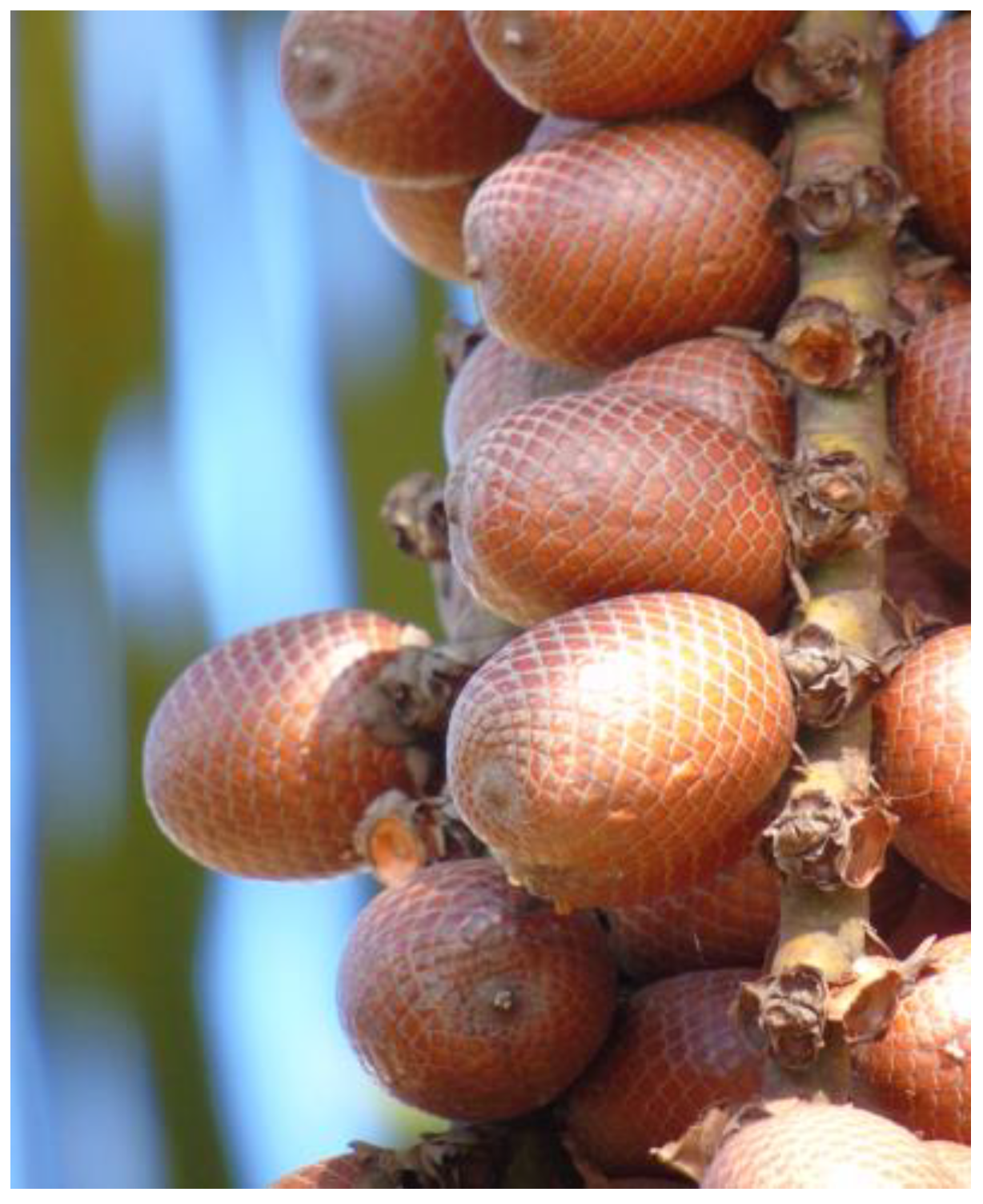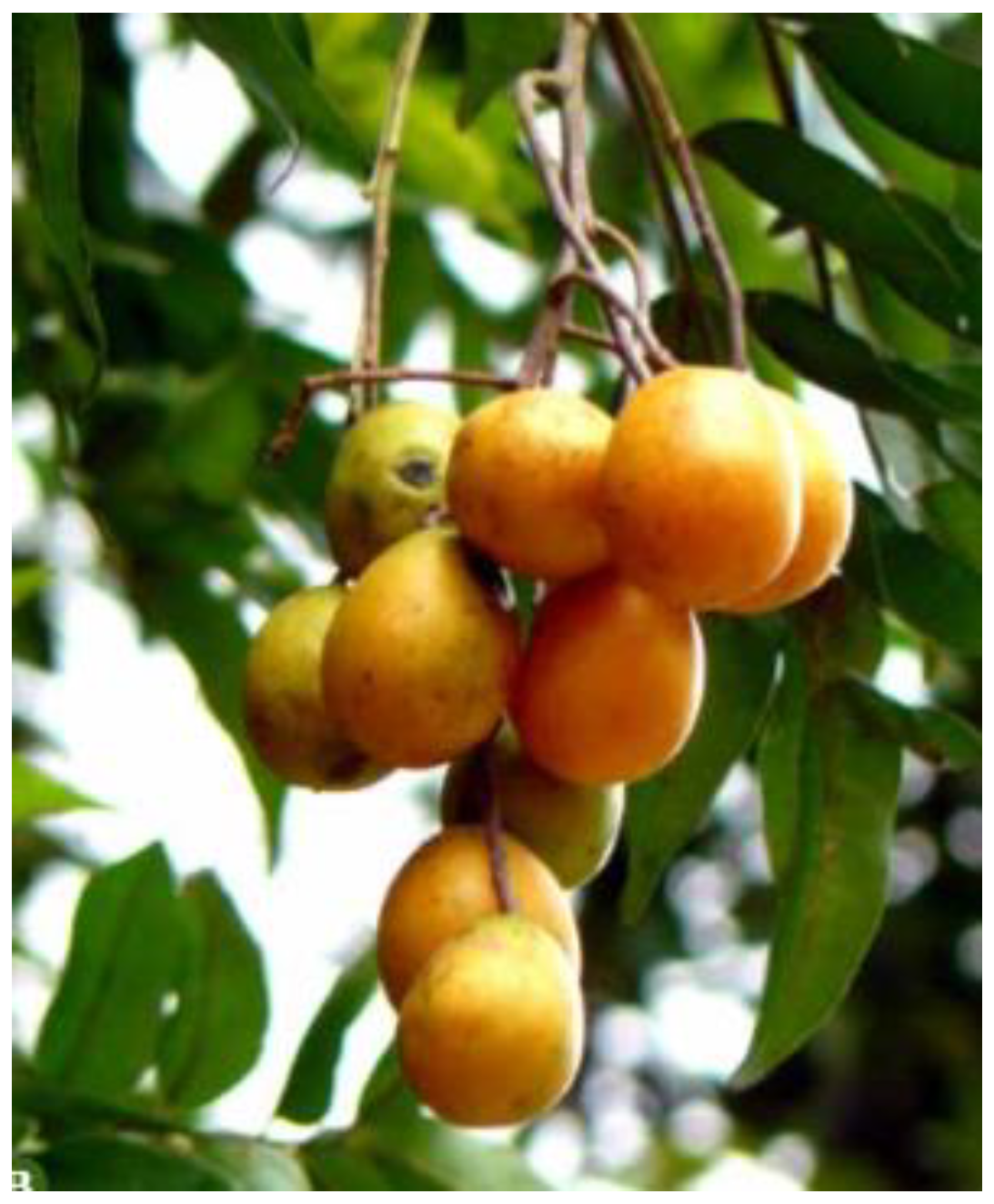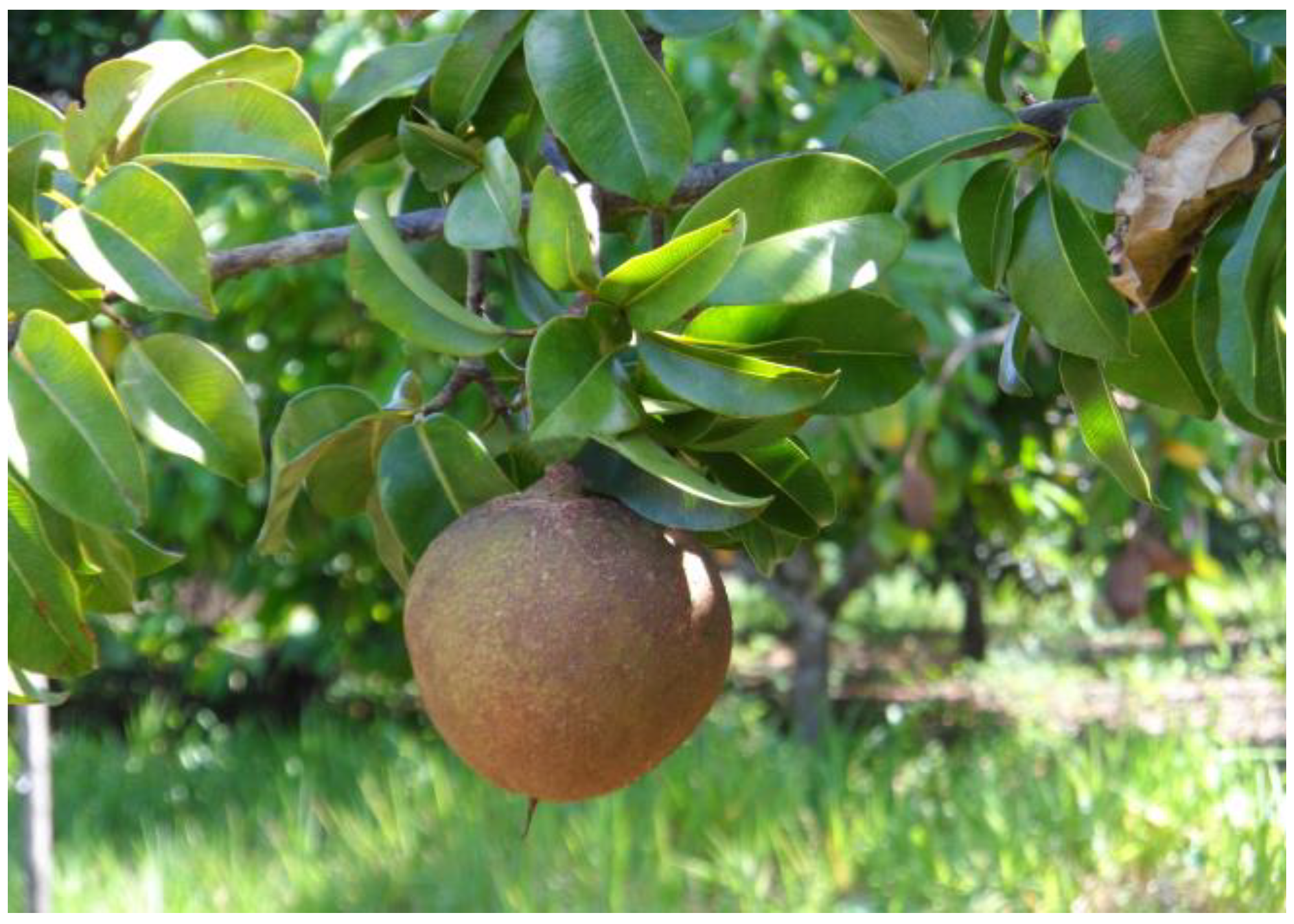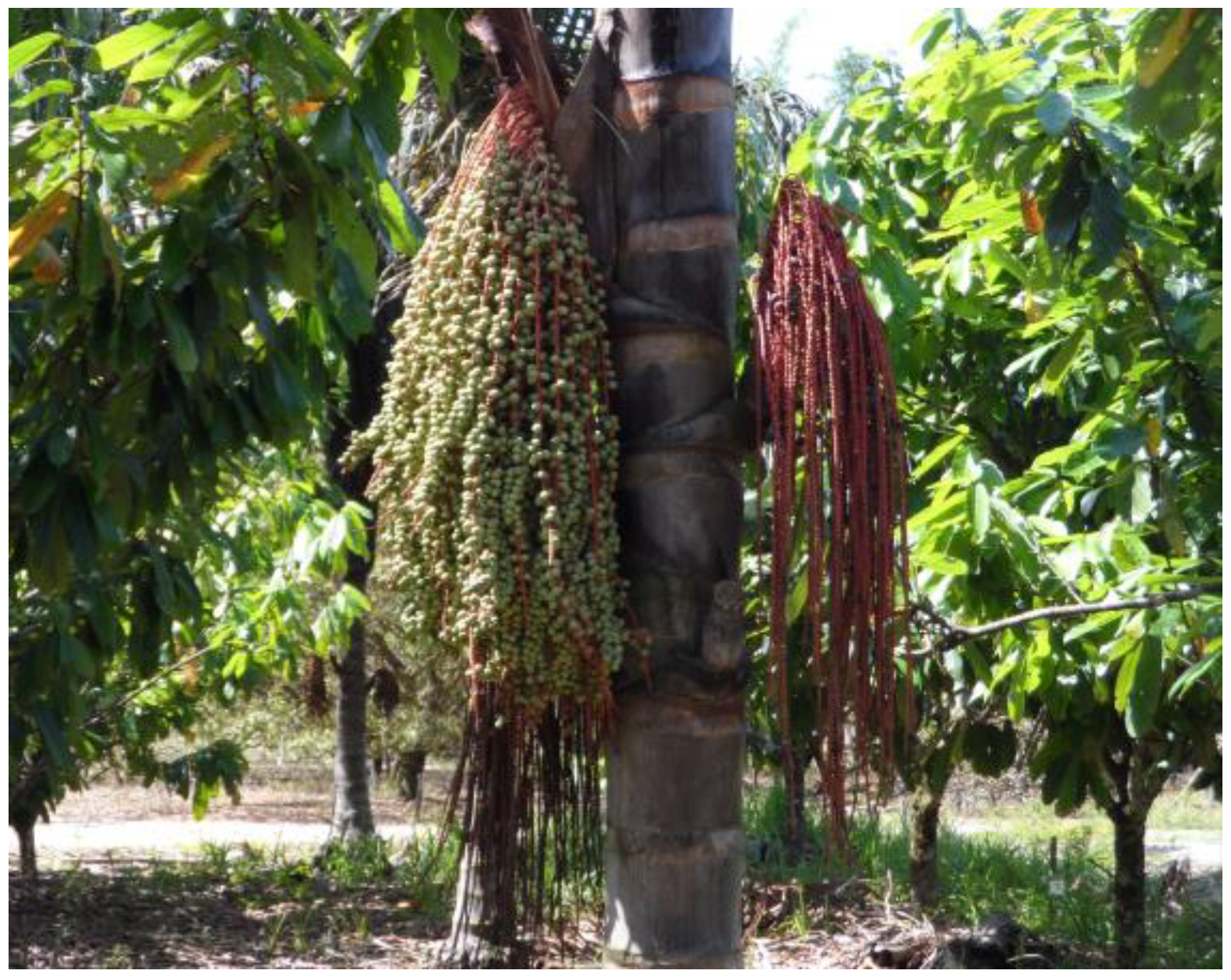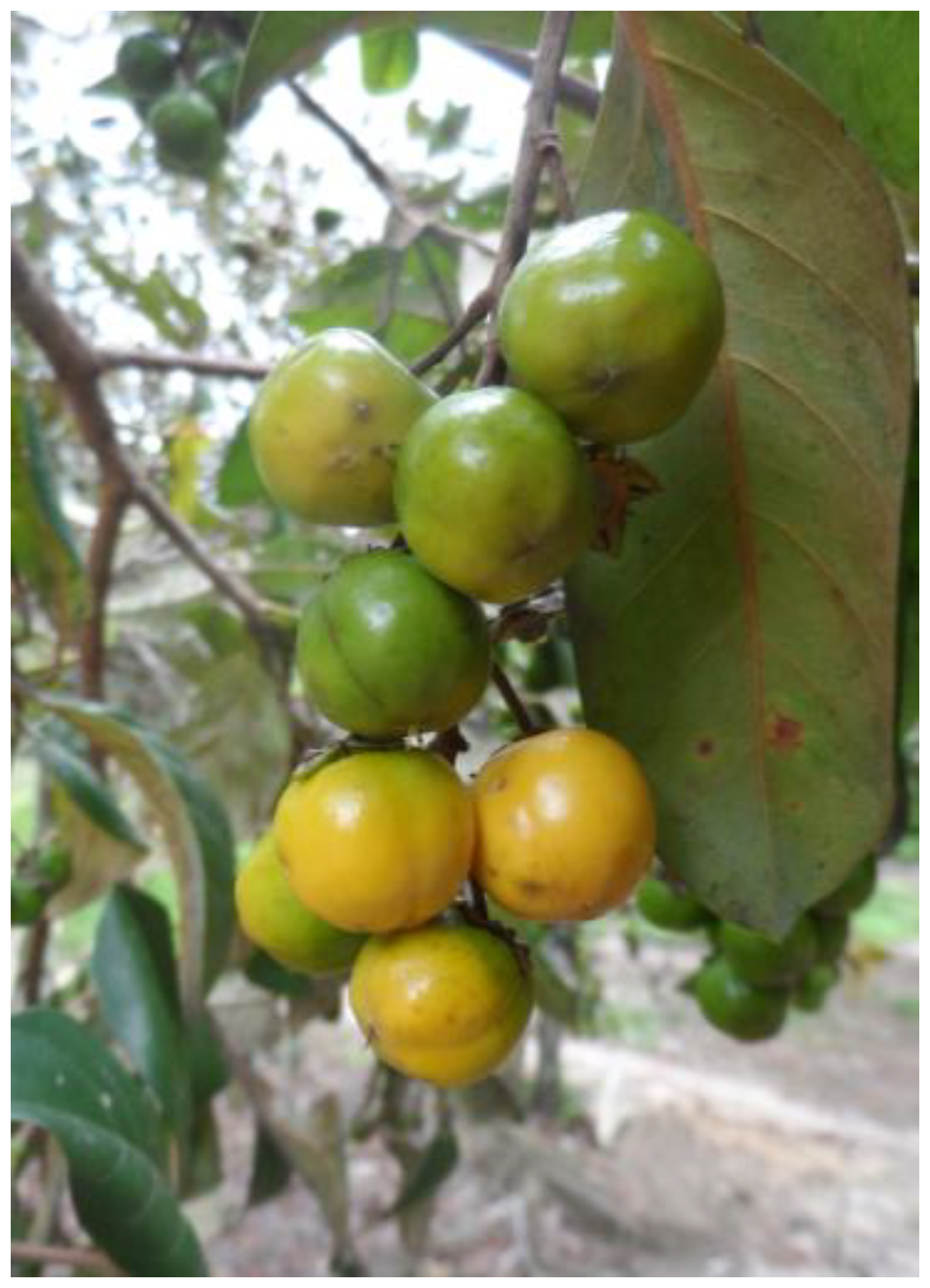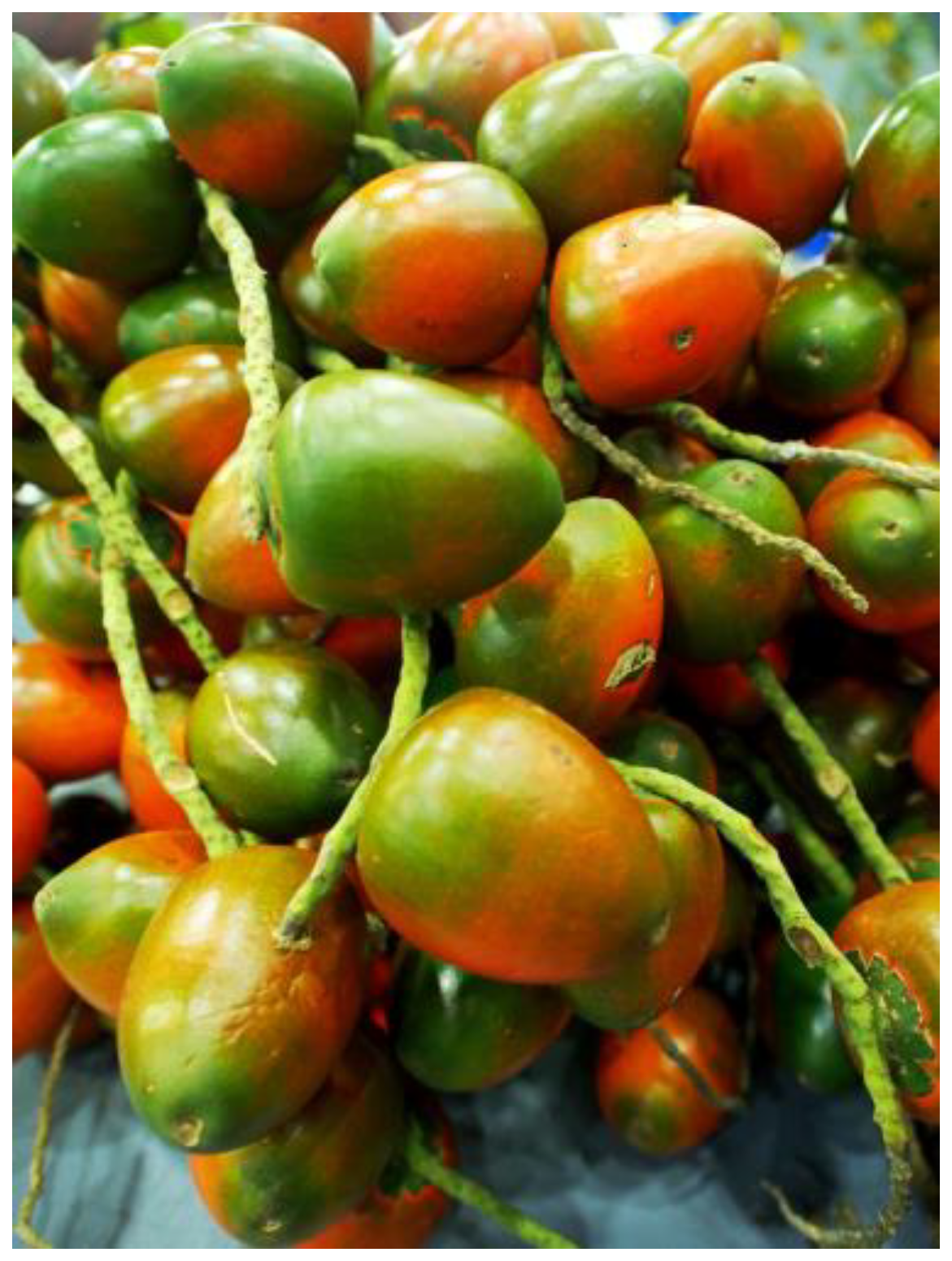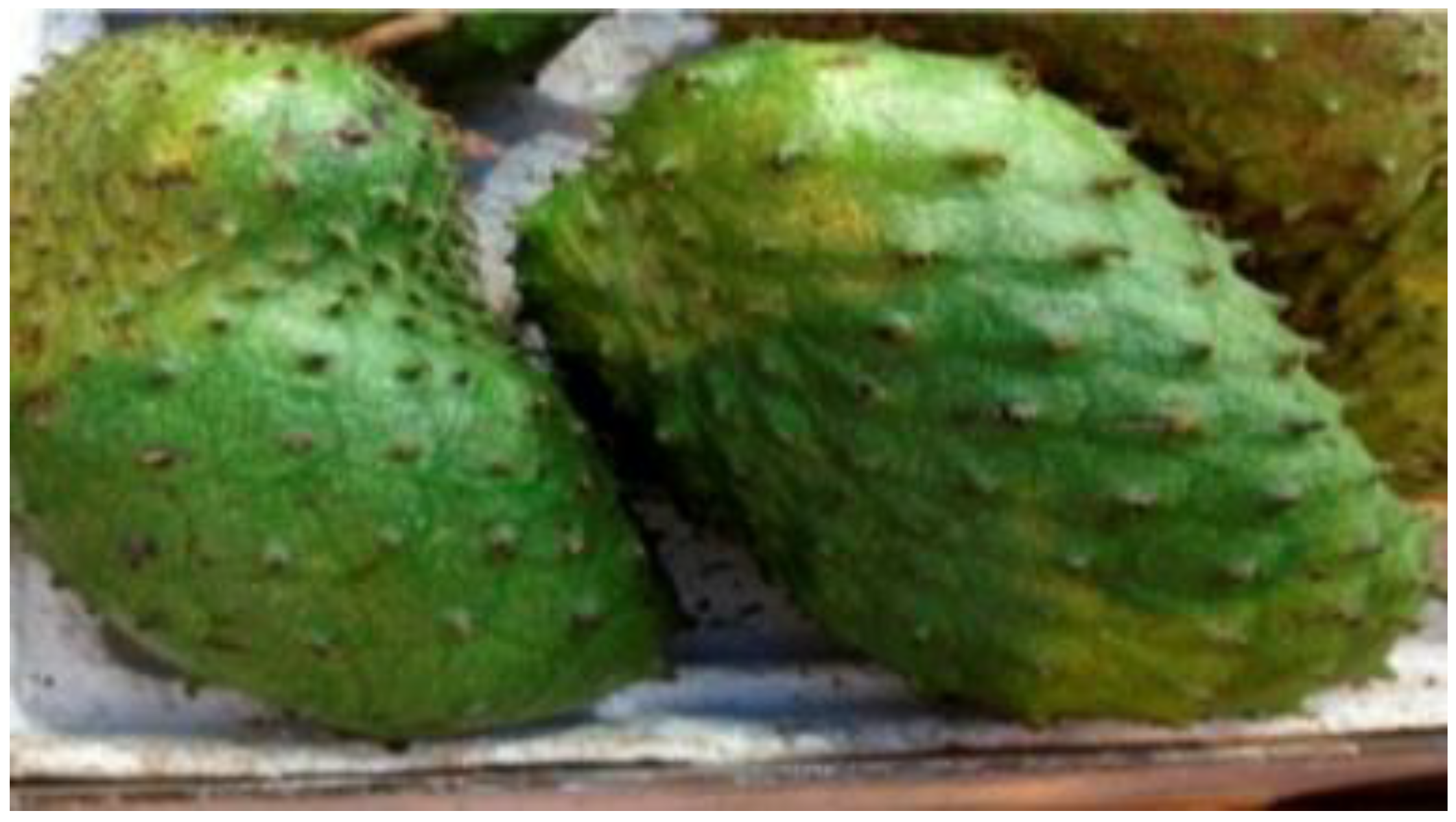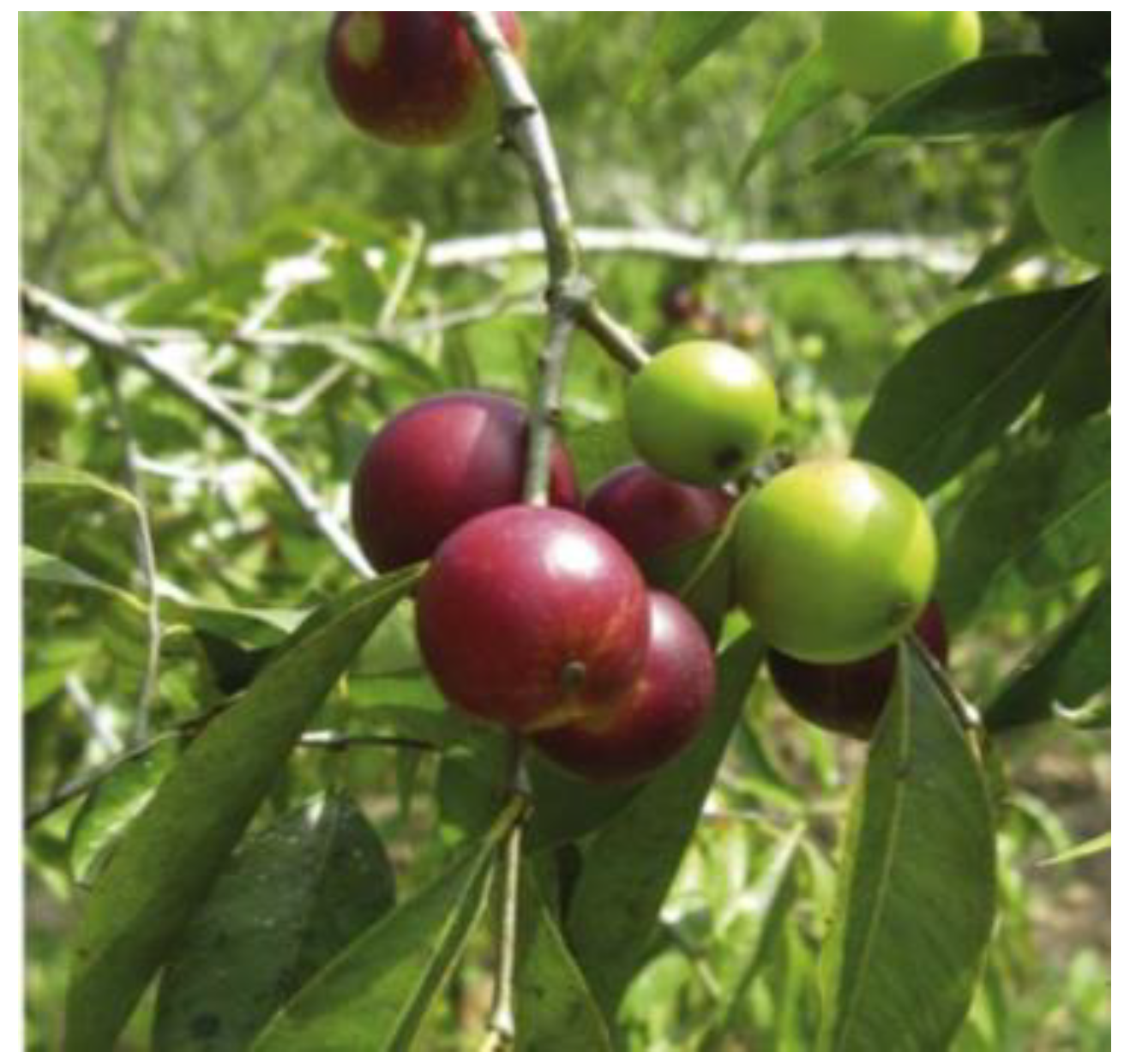The regular consumption of Amazonian fruits has been associated with the prevention of chronic diseases such as cancer, cardiovascular disorders, and diabetes. These health benefits are often attributed to the presence of bioactive compounds, including antioxidants, carotenoids, phenolic compounds, steroids, minerals, essential amino acids, and vitamins [
22]. Traditionally, these fruits have been used in indigenous medicine for a variety of treatments. Graviola, for example, is used in ethnobotanical practices in tropical regions to treat conditions such as diabetes, headaches, and hypertension [
23]. Another example is bacuri, which is traditionally used to treat various ailments, including skin problems, spider and snake bites, rheumatism, and arthritis [
24].
The following sections will explore various Amazonian fruits and the fermented beverages derived from them, with a focus on their nutritional properties and the presence of active substances, thereby highlighting the capacity of these species for the formulation of new nutritious and functional beverages.
2.1. Cupuaçu (Theobroma grandiflorum)
Popularly known as “cupuaçuzeiro”, “copoasu”, or “copuazú”, the species
Theobroma grandiflorum is a component of the Sterculiaceae family and is a tree that can grow between 15 and 20 m in height. Its fruit, cupuaçu (
Figure 1), has an oblong to ellipsoidal shape, with a light to dark brown peel [
25].
With a pH ranging between 3.4 and 3.7 and notable antioxidant activity (1.7–2.0 µM trolox/g), cupuaçu pulp is yellowish-white and, in addition to its seeds, accounts for approximately 57% of the total fruit weight. It is rich in antioxidants such as vitamin C (ascorbic acid) and vitamin E (tocopherols), as well as flavonoids, anthocyanins, and polyphenols. Additionally, it is a source of proteins, fats, carbohydrates, and minerals, including sodium, potassium, magnesium, phosphorus, and calcium (
Table S1) [
26,
27,
28,
29,
30,
31].
Among the main essential amino acids found in cupuaçu pulp are leucine, valine, and threonine (8.44 ± 0.15, 7.26 ± 0.15, and 5.92 ± 0.04 g/100 g of protein, respectively), while the predominant non-essential amino acids are glutamic and aspartic acids (14.83 ± 0.1 and 12.38 ± 0.26 g/100 g of protein, respectively) [
27]. The pulp also contains native starch with a prominent amylose content (71%), distinguishing it from starches present in fruits such as an apple (
Malus domestica) [
28].
Cupuaçu pulp also contains citric acid, which contributes not only to its sensory qualities but also to a more natural and effective preservation process by inhibiting microbial contamination and extending product shelf life [
29]. Moreover, the ascorbic acid content of the pulp represents approximately 30% of the recommended daily intake for individuals under the age of 18 (75 mg for men and 65 mg for women) and about 25% for those over 19 (90 mg for men and 95 mg for women). This makes cupuaçu a nutritious option for achieving recommended ascorbic acid levels, especially for individuals allergic to the dyes found in effervescent ascorbic acid supplements [
30].
The pulp of cupuaçu exhibits a notable lipid content of 12.7% on a dry matter basis, with palmitic acid (55.2%) and oleic acid (18.8%) constituting the dominant fatty acids. Remarkably, α-linolenic acid, an omega-3 fatty acid of nutritional relevance, accounts for 18% of total fatty acids, underscoring the pulp’s potential as a dietary source of essential polyunsaturated fats. Regarding mineral composition, cupuaçu pulp contains appreciable amounts of potassium (34.3 mg/100 g), phosphorus (15.7 mg/100 g), and magnesium (13.1 mg/100 g), along with trace elements such as zinc (0.53 mg/100 g), copper (0.26 mg/100 g), and manganese (0.21 mg/100 g). These findings highlight the nutritional level of cupuaçu pulp, particularly for its balanced lipid profile and mineral richness [
31].
In Brazil, cupuaçu pulp is consumed fresh or processed into juices, ice creams, popsicles, jams, and sweets due to its acerbity and strong aroma. Furthermore, it has attracted interest in the food service industry for its ability to enhance the physicochemical properties of dairy beverages, such as viscosity, water retention capacity, carbohydrate content, fatty acid profile, ascorbic acid, soluble fiber, and phenolic compounds, thereby improving their overall nutritional value [
32].
As a strategy to improve the sensory and dietary value of beverages, cupuaçu pulp and its derivatives have been incorporated into dairy and fermented drinks. Studies have demonstrated the use of cupuaçu in the formulation of a probiotic beverage fermented with
Lacticaseibacillus casei NRRL B-442. Under initial conditions of 34% (
w/
v) pulp, pH 5.8, and fermentation at 30 °C for approximately 18 h, the resulting beverage showed enhanced antioxidant activity (
Table 1) and was well accepted in sensory evaluations, highlighting its potential as a functional food alternative [
33].
As shown in
Table 1, among the carbohydrates present in cupuaçu pulp, fructose was the most consumed (a difference of 84.76%), followed by sucrose (62.10%) [
33]. During lactic fermentation, homofermentative lactic acid bacteria (LAB) convert sugars into lactic acid, whereas heterofermentative LAB produce lactic acid along with acetic acid, ethanol, and carbon dioxide. This microbial activity is required to produce fermented dairy products, such as yogurt and kefir [
34].
Furthermore, both cupuaçu pulp and flour have been investigated for use in the production of artisanal fermented dairy beverages. Initially, pasteurized whey and milk were employed as the liquid base, to which sugar and a starter culture composed of
Streptococcus thermophilus and
Lactobacillus delbrueckii subsp.
bulgaricus were added. Fermentation was carried out in a water bath for five hours at 42 °C until the pH reached 4.6. Depending on the treatment, cupuaçu pulp and/or flour were then incorporated into the fermented matrix. The study reported that higher pulp concentrations (10%) yielded a beverage with the characteristics summarized in
Table 2 [
35].
2.2. Açaí (Euterpe oleracea)
The term “açaí” is generally used to refer to the berries of the
Euterpe genus, yet it is primarily associated with
Euterpe oleracea Mart., commonly known as “açaizeiro”, “juçara”, or “açaí-de-touceiras”.
E. oleracea is associated with the Aceraceae family and is endemic to the eastern Amazon but also grows in Panama, Ecuador, Colombia, Venezuela, the Guianas, Suriname, and Brazil [
36].
The açaí fruit (
Figure 2) is spherical, measuring 0.9 to 1.3 cm in diameter, with a fibrous seed, a thin mesocarp (pulp), and a dark purple-black skin when ripe. Its pulp is rich in active products and antioxidants, mainly anthocyanins, proanthocyanidins, and other flavonoids [
37], some of which are mentioned in
Table S2.
Among the active substances that were identified in the edible portion of
E. oleracea, anthocyanins such as cyanidin-3-glucoside and cyanidin-3-rutinoside predominate. These anthocyanins are also predominant in the pap of another species of the
Euterpe genus,
E. precatoria. Although both species are commonly used to produce açaí, they exhibit distinct observable and chemical characteristics. One key difference is in the total anthocyanin content, which is 50% higher in
E. precatoria compared to
E. oleracea. Additionally,
E. precatoria contains pelargonidin-3-glucoside (319 mg/kg), while
E. oleracea contains peonidin-3-rutinoside (44 mg/kg) [
38].
Studies characterizing freeze-dried
E. oleracea pulp have reported a high presence of oleic acid (52.7%) and palmitic acid (25.56%), with levels similar to those found in açaí juices collected in the Brazilian State or region of Pará (60% and 22%, respectively). Notably, the oleic acid content in açaí pulp is higher than in cupuaçu. While palmitic acid is considered one of the most harmful saturated fatty acids in terms of cardiovascular disease risk, oleic acid is regarded as a neuroprotective agent [
31]. Among the minerals present in the freeze-dried pulp, potassium is the most plentiful, followed by calcium. The recommended daily intake for healthy adults is 4.7 g of potassium and 1000 mg of calcium, which may be easily met by consuming 200 g of freeze-dried açaí pulp [
39].
Consumption of açaí pulp has been associated with the prevention and management of various diseases, including diabetes, dyslipidemia, and cardiovascular conditions, by virtue of its high antioxidant activity, nutritional richness, and therapeutic benefits. Açaí can be consumed in various forms, such as jelly, liqueur, frozen pulp, syrup, cream, ice cream, and as an exotic beverage outside of Brazil [
40]. Given its nutritional properties, açaí has gained considerable economic value, particularly in the food sector. It is incorporated into energy drinks, shakes, smoothies, isotonic beverages, juices, and dietary supplements exported worldwide. Fermented beverages have also gained attention on account of their functional properties and high nutritional value [
41].
For example, a study on açaí pulp demonstrated the successful generation of a fermented beverage using
Lacticaseibacillus paracasei,
Leuconostoc mesenteroides, and
Lactiplantibacillus plantarum in a ratio of 0.5:1.0:1.5, under fermentation conditions of 6 days, with a nitrogen source supplementation of 2.5% and a temperature of 27 °C. This combination resulted in increased ash and protein contents. The raw açaí liquid showed changes in its basic physicochemical composition, as reflected in
Table 3, with protein content rising from 1.30 g/100 g to 2.77 g/100 g in the fermented açaí beverage. Changes also occurred in the amino acid profile. In the wine açaí liquid, glutamic acid, aspartic acid, leucine, lysine, and proline were detected (0.123, 0.108, 0.095, 0.072, and 0.066 g/100 g, respectively). After fermentation, elevated levels of glutamic acid, proline, leucine, valine, and phenylalanine were observed (0.614, 0.207, 0.109, 0.091, and 0.082 g/100 g, respectively), which provide a bittersweet flavor profile in the final product [
42].
As presented in
Table 3, seven volatile aroma compounds were produced following the fermentation process: n-propanol, isoamyl alcohol, acetaldehyde, isobutanol, ethyl acetate, ethyl formate, and dimethyl sulfur. Overall, the content of volatile compounds increased after fermentation, which can enhance the flavor of the fermented beverage. The oxygen radical absorbance capacity (ORAC), an indicator of antioxidant capacity, was measured in both raw and fermented açaí liquids. The values were 453.64 µmol/g trolox and 708.77 µmol/g trolox, respectively. These levels are comparable to those in sage spice (987.14 µmol/g trolox) and approximately 60 times higher than those in red grapes (16.40 µmol/g trolox), indicating a significant nutritional enhancement and the potential for development of highly nutritious formulations using açaí [
42].
Açaí-based liqueurs demonstrated high anthocyanin content, reaching 203 mg/L-significantly higher than levels typically found in grape juice (17.31 mg/L) and red wines (11–31.57 mg/L). This indicates the beverage’s potential as a rich source of phenolic compounds [
43].
2.3. Buriti (Mauritia flexuosa)
Analogous to the açaí palm,
Mauritia flexuosa (Kunth) McVaugh is a species in the Aceraceae family. Commonly known as “buritizeiro” or “miriti”,
M. flexuosa is the most copious palm in Brazil, restricted to South America and widely dispersed throughout the Amazon region. Almost everything in the buritizeiro is useful, but the most utilized part is its fruit (
Figure 3), buriti, which is characterized by a reddish-brown peel and yellowish pulp [
44].
Buriti pulp has a high moisture content (50.5 g/100 g) and fat content (19.0 g/100 g), with a lipid concentration higher than that of patauá (
Oenocarpus bataua), a species known for its oil-rich products. However, buriti contains linoleic acid that is sparsely distributed (2.1 g/100 g). With a tocopherol content of 1169 µg/g, buriti pulp is rich in α-tocopherol (37.2%
w/
w) and is recognized as an excellent source of vitamins A and E [
45]. Manhães and Sabaa-Srur [
46] also indicate a considerable presence of minerals, with potassium the prevailing element (218.00 mg/100 g), followed by calcium (80.49 mg/100 g) and manganese (40.34 mg/100 g). In addition, buriti pulp contains a high amount of total aromatic amino acids, which are important for human physiological functions as cofactors (
Table S3).
The concentration of phenolic compounds in buriti pulp varies with ripeness, with the notable presence of quinic acid, caffeic acid, chlorogenic acid, ferulic acid,
p-coumaric acid, and protocatechuic acid, along with flavonoids such as (+)-catechin, (−)-epicatechin, and luteolin, which are also abundant [
10]. Although the pulp contains lower levels of total phenolics, flavonoids, carotenoids, hydrolysable and condensed tannins, and ascorbic acid compared to the peel, it still retains significant amounts and exhibits high antioxidant capacity. Therefore, buriti pulp can be easily incorporated into the human diet to help meet daily nutritional requirements and can be consumed in processed forms such as sweets, ice creams, juices, jams, and wines [
10,
47].
The Kichwa tribe of the Ecuadorian Amazon and the Guahibo people from the eastern plains of Colombia and Venezuela ferment buriti juice to produce chicha de morete [
48]. Chicha is a traditional beverage that may be either fermented (alcoholic, with an alcohol content ranging from 1 to 12%
v/
v) or non-fermented (non-alcoholic), and it is often used in rituals and religious practices [
49].
Although no detailed studies exist on the process of producing chicha from buriti pulp, available reports indicate that both fermented and non-fermented versions are made by crushing the fruit. In the alcoholic version, the pureed fruit is left to ferment for 3 to 4 days, with the addition of liquid obtained from chewed sweet potatoes, which serves as a source of amylase and microorganisms [
49]. Microbiological analyses report the presence of yeasts—especially
Saccharomyces cerevisiae—as well as bacteria of the genera
Leuconostoc,
Acetobacter, and
Lactobacillus, in combination with various molds such as
Aspergillus spp., as the primary fermentative microorganisms in this traditional beverage [
50].
Additionally, buriti pulp has been evaluated for use in fermented milk production with
L. casei SJRP38, showing promising functional potential. The formulation involved reconstituted milk (12% total solids [
w/
v]) and 1% buriti pulp, subjected to heat treatment at 90 °C for 10 min, cooled to 42 °C, followed by inoculation with
L. casei SJRP38 (8 log CFU/mL), and fermented at 42 °C until reaching a pH of 4.6.
Table 4 shows that the fermented product made with buriti presented a high lipid content and minimal variation in total solids and ash contents, values close to those observed in passion fruit (11.65 and 1.28 g/100 g, respectively) [
51].
2.4. Taperebá (Spondias mombin)
Another Amazonian fruit with a distinctive flavor is
Spondias mombin (
Figure 4). Commonly known in Brazil as “cajazeiro”, “taperebá”, “cajá-mirim”, “cajazinho”, or “cajá” depending on the region,
S. mombin is a fruit-bearing species native to Brazil and distributed throughout tropical regions of the Americas, from southern Mexico to Brazil, including some Caribbean islands. The fruit is the primary edible part. It has an elliptical shape, a yellow-orange color, smooth fibrous skin, and a sweet-sour taste. The flesh and skin together account for approximately 38% of the total fruit weight, while the seed constitutes the majority [
52].
Beyond the fruit, the leaves, flowers, seeds, and bark of taperebá also have nutritional and ethnomedicinal applications, including treatments for abortion, fever, gonorrhea, postpartum hemorrhage, digestive pain, and wounds. Approximately 102 compounds have been isolated from several parts of the plant, highlighting its pharmacological importance.
Table S4 shows the physicochemical and nutritional aspects of
S. mombin pulp [
53].
Although
S. mombin pulp has low sodium and calcium contents, it is rich in magnesium, phosphorus, and potassium. Potassium levels are comparable to those observed in
Genipa americana (jenipapo) and
Hancornia speciosa (mangaba), and phosphorus levels are similar to those in
S. purpurea (seriguela),
Caryocar brasiliense (pequi), and passion fruit [
53]. Notably, to prepare 300 mL of juice from
S. mombin, 100 g of pulp is required, which provides approximately 5.8% of the recommended daily intake (RDI) of magnesium, 4.6% of phosphorus, 8.2% of potassium, and 4% of iron for adults [
54].
Cajá pulp has an elevated antioxidant capacity (17.47 mmol trolox/g), placing it among fruits with above-average antioxidant activity. It ranks alongside guava, plum, and strawberry and outperforms other Brazilian fruits such as umbu (
S. tuberosa) (1.07 mmol trolox/g), graviola (6.09 mmol trolox/g), sapoti (
Manilkara zapota) (0.99 mmol trolox/g), papaya (7.6 mmol trolox/g), and pineapple (3.78 mmol trolox/g) [
55].
Spondias mombin pulp is often employed in the preparation of juices, ice creams, and liqueurs owing to its content of carbohydrates, proteins, fibers, essential minerals, and bioactive compounds—particularly tannins (299.81 mg/100 g) and carotenoids (28.30 µg/g) [
56].
According to Alves et al. [
57], a formulation containing taperebá pulp (50%), sucrose, stevia, and fermented
Talinum triangulare (50% infusion at 10%
w/
v), fermented at 30 °C for 14 h, showed satisfactory sensory acceptance. Fermentation with
L. casei NRRL B-442 (7.00 log CFU/mL) was tested using
T. triangulare leaf tea and cajá pulp. Beverages containing blends of cajá pulp and
T. triangulare leaf tea sweetened with sucrose showed the highest microbial growth rates—45.43% and 40.45%, respectively—at initial pH values of 6.1 and 6.0. Over a 42-day storage period, these beverages showed minimal reductions in phenolic composition and free radical scavenging activity, with stevia-containing formulations exhibiting greater losses. The phenolic content of the beverage containing blends of cajá pulp showed a decrease from 2.90 to 2.75 mg/100 mL after 7 days and to 2.00 mg/100 mL after 42 days. Conversely, the beverage containing
T. triangulare leaf tea sweetened with sucrose showed a decrease from 1.90 to 1.85 mg/100 mL on day 7 and to 1.60 mg/100 mL on day 42. A comparable pattern was noted in DPPH antioxidant activity: the first beverage exhibited a 33.09% reduction, while the second beverage showed a 27.61% reduction over the 42-day storage period.
Taperebá pulp was also used as a substrate for
L. plantarum NRRL B-4496 to produce a synbiotic drink. The fermentation was carried out at 30 °C for 18 h with an initial pH of 4.5. A formulation using 100 g of frozen pulp per 200 mL beverage and 10% (
v/
v) of
L. plantarum showed pH stability over 28 days (ranging from 2.3 to 2.5) and a slight decrease in acidity (from 0.79 to 0.76 mg citric acid/mL), possibly due to citric acid degradation or reduced production (
Table 5). The soluble solids content peaked at day 21 (ranging from 7.73 to 8.80 °Brix), which may result from the acid hydrolysis of complex sugars. Total phenolic compounds increased from 271.7 to 320.5 mg GAE/L, comparable to an apple (339 mg GAE/L) and pineapple juice (358 mg GAE/L) [
58].
The proximate composition of taperebá mombin-based beverages, including fermented ones, was also determined (
Table 6). These drinks can be regarded as low-calorie and suitable for individuals with caloric restrictions [
58].
A successful application of taperebá pulp was likewise found in the production of ginger beer. The formulation included 4% grated ginger (
w/
v), mineral water, 1% lemon juice (
v/
v), 15% sugar (
w/
v), 15% taperebá pulp (
w/
v), and 25% ginger bug (
v/
v). The mixture was homogenized, filtered, and incubated at 25 °C for 14 days (
Table 7) [
59].
The taperebá-based fermented beverage showed high initial concentrations of organic acids such as malic (2.40 g/L), citric (0.57 g/L), lactic (0.09 g/L), succinic (0.08 g/L), acetic (0.11 g/L), formic (0.02 g/L), and butyric (0.46 g/L), indicating that the fruit contributed significantly to the beverage’s acidity. During fermentation, succinic and acetic acid levels increased, with succinic acid being an important stimulant of gastric acid production (
Table 7). Regarding alcohol content, the beverage was classified as low alcohol by Brazilian standards, with an alcohol content of approximately 2.3% after 14 days of fermentation. Several phenolic compounds, including procyanidin B1, gallic acid, (+)-catechin, procyanidin A2,
trans-caftaric acid, and rutin, were detected at high concentrations, helping to increase the beverage’s functional potential through their significant antioxidant effects and possible benefits in preventing chronic diseases [
59].
2.5. Bacuri (Platonia insignis)
The bacurizeiro (
Platonia insignis Mart.) is a unique fruit-bearing species within its genus. This multifunctional tree provides high-quality timber, medicinal exudates, seed-derived butter, and the highly valued fruit known as bacuri, which holds significant cultural and economic importance for certain Amazonian communities. The bacuri fruit is ovoid in shape (
Figure 5), weighs between 200 and 500 g, and is enclosed in a thick pale yellow to brown rind that accounts for approximately 65–75% of the total fruit weight [
60].
The pulp, which accounts for less than 15% of the fruit’s weight, is a source of essential minerals—such as sodium, potassium, calcium, magnesium, phosphorus, iron, zinc, and copper—as well as carbohydrates, bioactive compounds with antioxidant properties, dietary fiber, and amino acids, despite its low protein content [
61]. Although bacuri pulp has a lower total phenolic content (0.2–23.8 mg GAE/100 g) compared to taperebá (
S. mombin) (391.69 mg GAE/100 g), murici (
Byrsonima crassifolia) (271.60 mg GAE/100 g), and açaí (
E. oleracea) (708.22 mg GAE/100 g), it contains higher flavonoid levels (15.34–16.9 mg QE/100 g) than taperebá (14.949 mg QE/100 g), cupuaçu (
T. grandiflorum) (4.879 mg QE/100 g), and orange (
Citrus sinensis) (10.579 mg QE/100 g) [
62] (
Table S5).
Bacuri is typically consumed fresh but can also be processed into juices, ice cream, sweets, liqueurs, and milk-based beverages. A brewery located in Pará (Brazil), for example, won the “International Beer Challenge 2014” with a craft beer made with bacuri. Although the specific brewing parameters are not publicly disclosed, the 3.8% ABV beer is described as a fruit beer style—clear, light, with a good, persistent foam, and a fruity aroma attributed to maturation with bacuri [
63].
Bacuri pulp juice has also been evaluated for kombucha production. A green tea infusion (2 L of water with 14 g of
Camellia sinensis) and 40 g of sugar were used. The Symbiotic Culture of Bacteria and Yeast (SCOBY) was inoculated and incubated at 25 °C for 7 days before the addition of 20% of a formulation consisting of bacuri pulp (100 g pulp, 150 mL water, and 10 g sugar). The mixture was then bottled and stored away from light for 24 to 36 h. The resulting kombucha met safety and quality standards for this type of beverage. It contained 0.16 g/L of reducing sugars, 2.27 g/L of ethanol, and 318.3 mg GAE/L of total phenolic compounds—higher than those found in kombuchas produced with taperebá (34.92 mg GAE/L) and cupuaçu (33.40 mg GAE/L). The beverage also presented antioxidant activity of 307.98 μmol TE/mL and a vitamin C content of 375.25 mg/100 mL, exceeding values found in kombucha from cupuaçu (360.57 mg/100 mL), suggesting that bacuri is a promising raw material for developing nutritious beverages (
Table 8) [
64].
Bacuri pulp has also shown potential in the development of whole, semi-skimmed, and skimmed yogurts. The process involved heating the milk (whole, semi-skimmed, or skimmed) to 45 °C, followed by the addition of 3% (
w/
w) lactic starter cultures (
Streptococcus salivarius subsp.
thermophilus and
L. delbrueckii subsp.
bulgaricus) and 15% (
w/
w) sucrose. The mixture was incubated at 43 °C until the acidity reached between 0.87% and 0.90% lactic acid. After breaking the curd by stirring and cooling, bacuri pulp was added at 15% (
w/
w), followed by filling and storage at 6–8 °C [
65].
As shown in
Table 9, the yogurts formulated with bacuri pulp displayed lipid contents within the limits established by the Brazilian Health Regulatory Agency (ANVISA): 3–5.9% for whole yogurt, 0.6–2.9% for semi-skimmed, and a maximum of 0.5% for skimmed yogurt. The addition of bacuri pulp led to fat reductions of 75% and 79.16% in semi-skimmed and skimmed yogurts, respectively, compared to whole milk yogurts. These products can thus be classified as light or low-fat, offering innovative flavors while promoting health benefits for consumers [
66].
2.6. Bacaba (Oenocarpus bacaba)
Native to the Amazon rainforest, bacaba (
Oenocarpus bacaba Mart.), also known as “red bacaba”, “bacaba-açu”, or “bacabão”, is a palm species found in both the Amazon and Cerrado biomes of Brazil. This species has a variety of traditional uses: its seed oil is used in cooking; its palm heart juice is employed by the Yagua people to treat scorpion and venomous spider bites; its wood is utilized by the Yanomami native people for making bows, posts, and beams; and its leaf petioles are woven into tapetis used for pressing cassava. Additionally, its fruits (
Figure 6) are an important source of bioactive compounds with potential biotechnological relevance [
48,
67].
Bacaba fruits grow in dense clusters and are approximately 1.5 cm in diameter, with a dark purple hue. They have a high lipid content (38.3% of pulp) [
3]—greater than that found in fruits such as bacuri (
Platonia insignis, 1.46 g/100 g) and açaí (
E. oleracea, 6.12 g/100 g)—along with a significant concentration of phenolic compounds, surpassing those detected in açaí pulp.
Table S6 shows some of the major characteristics of bacaba pulp.
The fruit is also rich in bioactive compounds, pigments, and natural antioxidants, making it a promising ingredient for dietary and functional food applications. Phenolic compounds reported in bacaba pulp include C-glycosides, flavonoids, C-hexosides, C-glycosylflavones, isorhamnetin hexoside, quercetin hexoside, and quercetin diglycoside. Among the anthocyanins detected are cyanidin glycoside and cyanidin hexoside, identified by HPLC-DAD-ESI-MS. It is worth noting that the pulp has not yet been fully characterized, and detailed compositional data remain scarce [
68].
By virtue of its fibrous and lipid-rich pulp, bacaba is primarily consumed in beverage form, but it is also used in jellies, ice creams, and fermented drinks. The Umutina Indigenous people traditionally prepare a fermented bacaba beverage known as chicha de bacaba. This beverage can be prepared with cereals and fruits via spontaneous fermentation or consumed immediately as a non-fermented version. The preparation involves selecting the fruits, boiling them, allowing them to rest for 30 min, and replacing the water. The fruits are then mashed in a wooden mortar, and the skins and seeds are removed using a sieve. Sugarcane juice is then added, and the beverage can be consumed fresh or fermented for approximately 30 h at room temperature [
69]. The resulting beverage has been characterized for microbial and physicochemical parameters, showing the appearance of mesophilic bacteria, lactic acid bacteria, and yeasts at concentrations of 4.8, 4.9, and 4.8 log CFU/mL, respectively. The final beverage had a pH of 6.2 and an energy value of 76.7 kcal/100 mL, as shown in
Table 10 [
69].
“Chicha de bacaba” is notable for its high lipid and protein contents and is consumed by Indigenous communities in the Colombian Amazon, including the Huitoto, Andoque, Yukuna, Muinane, and Miraña peoples. It contributes significantly to their intake of fats and carbohydrates [
69]. Among the fatty acids identified in bacaba pulp are palmitic, oleic, and linoleic acids, accounting for approximately 22%, 61%, and 12% of total lipids, respectively [
70].
Furthermore, significant concentrations of succinic, acetic, and citric acids have been detected. The beverage has a low ethanol content (0.52 g/L), and the absence of methanol classifies chicha de bacaba as a non-alcoholic beverage. These features underscore the nutritional value of bacaba as a dietary supplement and highlight its potential for broader application despite its current underutilization [
69].
2.7. Murici (Byrsonima crassifolia and B. verbascifolia)
Commonly known as “murici” or “beach murici”,
Byrsonima crassifolia (L.) Kunth and
Byrsonima verbascifolia (L.) DC. are members of the Malpighiaceae family and are predominantly found in the northern and northeastern regions of Brazil. The most consumed part of these species is their small yellow fruit (
Figure 7), approximately 2 cm in diameter, which is mainly collected by local populations [
71].
Murici fruits have a high moisture content (77.4%), which is greater than that of other Amazonian fruits such as buriti (
M. flexuosa, 50.5%) [
72]. This high moisture contributes to the fruit’s susceptibility to enzymatic and microbial deterioration, necessitating prompt processing. The fruit also contains significant amounts of crude fiber and lipids, about 63% of which are unsaturated fatty acids. Oleic acid is the predominant fatty acid, followed by palmitic and linoleic acids [
73] (
Table S7).
Headspace analysis identified 12 volatile compounds in murici pulp, with esters of hexanoic and butanoic acids contributing significantly to its characteristic aroma [
71]. Another noteworthy attribute is its substantial vitamin E content, which surpasses that found in fruits such as kiwi (1.450 µg/100 g) and peach (1.230 µg/100 g) [
72].
The consumption of 86 g of pulp (approximately 70 kcal) can fulfill about 40% of the recommended daily fiber intake for children, adults, and pregnant women. Additionally, one portion provides around 93.7% and 26% of the daily vitamin C requirements for children and adults, respectively [
74]. Despite its economic and nutritional relevance, murici remains underexplored, particularly regarding its physiological and chemical behavior under different environmental conditions. Most current applications involve extracts for pharmaceutical and cosmetic purposes, with relatively few studies investigating the fruit’s use in beverages, pastes, purées, and jams [
75].
A study carried out by Couto et al. [
76] that fermented dairy beverages incorporating murici pulp (5%
w/
v) and passion fruit peel flour (
Passiflora edulis Sims) at varying concentrations (0.0%, 0.5%, 1.0%, and 1.5%
w/
v) used a 2.5-L dairy base composed of 30% skimmed whey and 70% whole milk. The mixture included 10% sucrose and was pasteurized at 90 °C for 3 min. After cooling to 42 °C, cultures of
S. thermophilus,
Lacticaseibacillus acidophilus, and
Bifidobacterium lactis were inoculated. Once fermentation reduced the pH to 4.5, murici pulp and passion fruit peel flour were added, resulting in a beverage suitable for high-protein diets. These authors reported an increase in antioxidant activity. The beverage without passion fruit peel flour exhibited an EC
50 of 238.244 g/L, while the beverage with 1.5% flour showed an EC
50 of 224.302 g/L, attributed to the contribution of the passion fruit component (
Table 11). Although the authors did not evaluate other concentrations of murici pulp, the version without passion fruit peel flour received the highest sensory evaluation scores, indicating a clear preference for the murici flavor [
76].
Other research has focused on murici-based yogurt formulations [
77]. One successful formulation used whole pasteurized milk (3% fat) and 10% crystalline sugar per liter. After inoculation with
S. thermophilus,
L. acidophilus, and
Bifidobacterium spp., fermentation was carried out at 43 °C for 6–7 h until gel formation. After cooling, 5–15% murici pulp was added, followed by homogenization and packaging for storage at 5 °C. Although the associated patent did not provide detailed information on the final product characteristics, it highlights the potential for using murici as a flavoring agent and its growing appreciation as a native Amazonian fruit in dairy beverages.
2.8. Pupunha (Bactris gasipaes)
The peach palm (
Bactris gasipaes Kunth) is a tropical palm tree reaching up to 20 m in height and is distributed from southern Mexico to Brazil and Paraguay. It is valued for both its heart of palm and its fruit (known as pupunha) (
Figure 8), which are widely consumed in local cuisine [
78]. The skin of pupunha varies in color—red, orange, or yellow—and its pulp is highly nutritious. The fruits typically measure 4–6 cm in length and 3–5 cm in width. The fruit pulp exhibits a high carbohydrate content (an average of 86.35 g/100 g of dry matter), followed by notable amounts of lipids, proteins, and dietary fiber [
79] (
Table S8).
Daily intakes of 2000 mg of potassium, 2–5 mg of manganese, and 10 mg of iron are recommended, all of which can be supplied by consuming a 250 g portion of pupunha fruit [
79]. In addition, the content of phenolic compounds in pupunha (2.11 mg GAE/g dry matter) is higher than that found in rice (0.90 mg GAE/g dry matter) and guava (0.84 mg GAE/g dry matter), highlighting its potential as a source of phenolics for dietary intake [
80].
Carotenoid-rich extracts have also been successfully obtained from pupunha pulp using supercritical CO
2 extraction. The antioxidant activity of these extracts (10.3%) was statistically similar to that of caffeic acid [
81]. Carotenoids are a class of pigments responsible for the red, yellow, and orange colors in fruits and vegetables, and they also occur in green vegetables. These compounds are known for their health-promoting effects and are abundantly present in pupunha, which exists in a wide range of varieties [
82]. Among the carotenoids already identified in raw pupunha pulp are all-
trans-β-carotene, all-trans-δ-carotene,
cis-γ-carotene 2, and all-
trans-γ-carotene. An interesting fact is that to be consumed, pupunha needs to undergo heat treatment, which in turn favors the appearance of new carotenoids such as all-
trans α-cryptoxanthin, 15-
cis-β-carotene,
cis-δ-carotene, cis-γ-carotene 1, and lycopene.
Table S8 also shows that the total carotenoid content in cooked pupunha pulp—its traditional form of consumption—is 115.6 μg β-carotene/g fresh weight. This exceeds the values found in fruits such as banana (10.62 μg/g), guava (42.98 μg/g), and watermelon (40.09 μg/g) [
83].
Raw pupunha should not be consumed on account of the presence of antinutritional factors such as calcium oxalate crystals, lectins, specific polyphenols, saponins, and inhibitors of amylase and trypsin. It must be boiled in salted water for 30 to 60 min prior to consumption [
84]. Beyond direct consumption, pupunha fruit is used to produce flour, oils, ice cream, and fermented beverages. Usage of pupunha in fermented drinks has its roots in Indigenous traditions from the Amazon and Andes, where such beverages were prepared for ceremonial purposes. Depending on the region and ethnic group, variations exist in the raw materials used and fermentation times, with the common addition of salivary ptyalin (amylase) to aid in starch hydrolysis [
85].
One example is chicha or masato, traditional South American beverages sourced from the spontaneous fermentation of various starchy substrates. These drinks may have probiotic properties, as certain species of lactic acid bacteria isolated from them have shown antagonistic activity against pathogenic microorganisms [
86].
One method of producing a fermented pupunha beverage involves boiling the fruit and mashing the pulp. Simultaneously, a portion of the pulp is chewed—typically by women—to introduce salivary enzymes and then mixed with the mashed pulp. The mixture is left to ferment for several days, during which alcohol content can rise to 2–5%. After fermentation, the mass is diluted with water and sieved to remove fibers [
48,
86].
A successful formulation included 1 kg of fruit, 4 L of sucrose solution, and 1%
Saccharomyces cerevisiae. The fermentation at 27 °C for seven days produced a uniform orange beverage with 12.74% alcohol. Carotenoid levels stabilized at 2.2 mg/100 mL of must during fermentation. The pH dropped from 6.0 to 3.5, and the beverage was described as having a pleasant flavor and aroma, with a high acceptability rate of 81.9% (
Table 12) [
85].
Therefore, similar to other Arecaceae family fruits such as açaí (
Euterpe spp.) and bacaba (
Oenocarpus bacaba Mart.), pupunha fruits hold strong potential for the development of nutritious fermented beverages. The high carotenoid content of the pulp further supports pupunha’s value as a primary dietary source of vitamin A precursors [
87].
2.9. Graviola (Annona muricata)
Known as “guanabana”, “sauersak”, “guayabano”, or “soursop”,
Annona muricata belongs to the Annonaceae family and is native to tropical regions, being widely distributed across the Caribbean and Southeast Asia. The pulp, leaves, and seeds of
A. muricata are rich in phenolic compounds (
Table S9), making the plant a promising source of bioactive substances with potential applications in the pharmaceutical, cosmetic, and food industries [
88,
89,
90,
91,
92].
One important bioactive compound identified in graviola pulp is 5-caffeoylquinic acid, which is also found in coffee and exhibits antioxidant, antibacterial, anticancer, antihistaminic, and other biological activities. Another compound of interest is
p-coumaric acid, with levels reaching 0.94 mg/100 g fresh weight (FW), comparable to those found in orange juice (1.0 mg/100 g FW) and apple juice (1.2 mg/100 g FW) [
93].
Graviola fruit has a heart-like shape with a green, spiny rind, measuring 10–20 cm in diameter and weighing up to 15 kg (
Figure 9) [
94]. As shown in
Table 13, its pulp juice is characterized by a high moisture content and elevated levels of phosphorus and carbohydrates.
Table S10 shows notable concentrations of vitamin A (14.45 mg/100 g) and ascorbic acid (19.4 mg/100 g), the latter being a compound with well-documented antioxidant properties [
95]. The pulp is white, aromatic, and has a distinctive, mildly acidic, and sweet flavor. Additionally, soursop has been associated with a range of biological activities, including thrombolytic, antidiarrheal, cytotoxic, and antioxidant effects [
96].
In vitro studies using methanol-soluble fractions of the graviola pulp have demonstrated thrombolytic, antibacterial, and antidiarrheal activities. Thrombolytic assays showed that a concentration of 10 mg/mL induced maximum clot lysis of 18.33%, compared to 55.50% for the standard streptokinase. For antidiarrheal evaluation, diarrhea was induced in albino mice using castor oil, and all tested doses (100, 200, and 400 mg/kg body weight) showed significant effects, with 400 mg/kg achieving 58.38% inhibition [
97].
Further investigation into the cytotoxic and antioxidant properties of aqueous and alcoholic extracts from freeze-dried graviola pulp revealed significant activity against human tumor cell lines. The most potent cytotoxic effects were observed against PC3 (prostate carcinoma) (0.8460 µg/mL) and HeLa (cervical carcinoma) (7.1940 µg/mL) cells. In antioxidant assays using the DPPH method, the extract demonstrated a 69.77% radical scavenging activity. These findings are particularly important given the insufficient data on the antioxidant potential of different graviola tissues [
98].
Graviola pulp constitutes approximately 83–85% of the total fruit weight and is commonly consumed as juice. It is also used in the production of nectar, ice cream, and jams. A study investigating the production of wine from graviola pulp using propagated indigenous yeast yielded a beverage with 16% (
v/
v) alcohol [
99]. The indigenous yeast was obtained from soursop juice fermented for two days, which was aseptically inoculated using the streak plate technique on SDA (Sabouraud Dextrose Agar) containing 500 mg of chloramphenicol per plate. The pasteurized pulp was fermented with 15 g/100 mL of sucrose and nutrients (0.08 g KH
2PO
4, 0.06 g ammonium sulfate, and 0.02 g sodium metabisulfite) for 10 days. The wine reached a pH of 4.5 and showed an increase in alcohol content from the initial stages of fermentation. The indigenous yeast contributed to the fermentation process, which resulted in several changes in the physicochemical properties of the pulp (
Table 14).
Additionally, fermentation resulted in increases in titratable acidity, lipid, and alcohol content, while reducing fiber, protein, carbohydrate, pH, vitamin C, and ° Brix values. Despite these reductions, the fermented product retained several nutritionally important components [
99].
Graviola has also been used in beer production. For this, 3.7 kg of Pilsen malt and 0.3 kg of Vienna malt were milled and mixed with 16 L of water at 70 °C, then transferred to a mash tun at 68 °C for 60 min [
100]. After a 15-min mash-out at 78 °C, the wort was clarified via gravity recirculation. Boiling was performed with 15.4 g of hops added after 40 min, and the total boiling time was 60 min. After resting at 29 °C, the wort was transferred to a fermentation tank and inoculated with 8.05 g of yeast previously hydrated in 100 mL of mineral water. Fermentation proceeded at 19 °C for 7 days, followed by maturation at 0 °C for 10 days. The final product was filtered and bottled with 12 mL of priming solution (
Table 15).
2.10. Camu-Camu (Myrciaria dubia)
Commonly known as “camu-camu,” “caçari,” “araçá d’água,” or “sarão,”
Myrciaria dubia (HBK) McVaugh belongs to the
Myrtaceae family and is native to northern Brazil, as well as neighboring countries such as Peru, Colombia, and Venezuela [
101]. It typically grows along the banks of rivers and lakes in the Amazon basin, particularly during seasonal floods. Camu-camu produces globose fruits measuring approximately 2.5 cm in diameter (
Figure 10), which are renowned for their exceptionally high vitamin C content, ranging from 0.96 to 2.99 g/100 g, significantly higher than other common sources such as orange juice, thus highlighting its substantial nutritional and economic potential (
Table S11) [
102].
Beyond its remarkable vitamin C concentration, another notable feature of camu-camu is the peak in antioxidant activity and bioactive compound content—such as ascorbic acid (4752.23 mg/100 g of pulp), anthocyanins (52.6 mg/100 g of pulp), and total phenolics (12,798.80 mg GAE/100 g of pulp)—observed during the intermediate stage of ripening, when the peel exhibits a green-reddish coloration. These levels tend to decline as ripening progresses [
103].
Camu-camu contains a diverse array of phytochemicals, amino acids, essential fatty acids, and minerals such as potassium, iron, selenium, calcium, and magnesium (
Table S11). It is internationally recognized as a “superfruit” because of its numerous health-promoting properties, and its bioactive compounds can contribute to the prevention or delay of various diseases [
104]. Schwertz et al. [
105] investigated the hypolipidemic effect of camu-camu juice in rats and demonstrated its potential to modulate lipid profiles. After inducing dyslipidemia with a high-fat diet for 21 days, rats were treated with different concentrations of camu-camu juice (0.4 mL/kg, 4.0 mL/kg, and 10 mL/kg) for 14 days. A control group received quercetin (10 mL/kg). The most effective treatment was the 10 mL/kg dosage, which reduced triacylglycerol levels from 166.4 mg/dL to 56.1 mg/dL and total cholesterol from 178.9 mg/dL to 147.4 mg/dL. Although quercetin produced slightly stronger effects, the juice still showed considerable potential and provided a useful concentration reference for future studies.
Due to its high acidity (pH 2.51–2.54), camu-camu is most often consumed in processed forms such as frozen pulp, which facilitates its use in juices, ice creams, jams, and other formulations that allow dilution of the fruit’s acidity [
106]. Additionally,
M. dubia pulp has proven suitable for producing fermented beverages. According to Maeda and Andrade [
107], to reduce the bitterness, the pulp is blanched at 90 °C for 7 min. To obtain a final alcohol content of 12 °GL, sugar is added to the must, which is then mixed with the pulp and transferred to a fermentation vat. A total of 18 L of potable water and
Saccharomyces cerevisiae (20 g of baker’s yeast per 2 L of must) is added, and fermentation proceeds for 25 days at 25 °C. Following fermentation, the beverage is bottled, pasteurized (70 °C for 15 min), cooled, and filtered.
As shown in
Table 16, the fermentation process yielded good alcohol production (44.5%) and high fermentation efficiency (87%), demonstrating the suitability of the selected medium and conditions. The final beverages reached an alcohol content of 11%, regardless of whether the pulp was blanched. Sensory analysis revealed acceptability rates of 69.2% and 70.1% for beverages made with blanched and unblanched pulp, respectively [
107].
Another study highlighted the successful application of camu-camu in a fermented dairy beverage [
108]. Thus, milk is heated (90 °C for 15 min), cooled, and inoculated with a dairy starter culture (
S. salivarius subsp.
thermophilus and
L. delbrueckii subsp.
bulgaricus), then fermented at 42 °C until the pH drops from 6.0 to 4.5 and titratable acidity exceeds 0.90% lactic acid. After fermentation, camu-camu pulp is added at concentrations of 10%, 13%, and 15%. As shown in
Table 17, the final product has an average pH of 4.08 and a titratable acidity of 1.01%, suggesting a high organic acid content. The lactic acid levels are within the legal range for fermented dairy beverages (0.60–2.00%).
2.11. Other Fruits from the Amazon Region
In addition to the fruit species discussed throughout this review, the potential of using other Amazonian species to produce fermented beverages should be highlighted, as many other fruits could be used in a sustainable approach to provide innovative beverage products. One such example is tucumã (
Astrocaryum aculeatum), a palm native to northern Brazil, primarily found in the states of Acre, Amazonas, Rondônia, and Roraima. Its ellipsoid, globose, and smooth fruits measure approximately 5 to 6 cm in diameter, weigh around 70 to 75 g, and vary in color from yellow to orange or red [
109]. The pulp is highly valued for its high oil content (around 30%) and is composed predominantly of unsaturated fatty acids (approximately 70%), with oleic acid accounting for 63.5% and palmitic acid for 25%. In addition to its promising composition of bioactive compounds, tucumã pulp contains significant levels of α-tocopherol (142.4 μg/g of oil), β-tocopherol (5.6 μg/g of oil), carotenoids (1637.1 μg/g of oil), quercetin (14.51 mg/100 g of pulp), and gallic acid (10 mg/100 g of pulp) [
110].
Another potential raw material for fermented beverages is araçá-boi (
Eugenia stipitata McVaugh). This fruit can be consumed fresh or processed into jam, jelly, juice, ice cream, or mousse [
31]. Its pulp contains relevant nutritional compounds, including proteins (0.6 to 1.0 g/100 g), nitrogen (152.7 mg/100 g), potassium (215.3 mg/100 g), iron (87 ppm/100 g), vitamin A (7.8 µg/100 g), vitamin B1 (9.8 µg/100 g), vitamin C (0.2 to 101.1 mg/100 g), and total phenolics (0.6 to 274.12 mg/100 g), positioning the fruit as a nutraceutical ingredient suitable for functional beverages [
111].
Best known for its high caffeine content (ranging from 2.7 to 5.8%) and its use in the energy drink industry, guaraná (
Paullinia cupana) is a species domesticated by the Sateré-Mawé people from the lower Madeira River in the Amazon region. It is considered a strategic crop for supplementing the income of small farmers in the Amazon basin. Guaraná is commonly consumed in the form of extracts, syrups, energy drinks, or soft drinks [
3,
112]. One of the few studies to investigate the production of fermented beverages using guaraná reported that the combination of kefir (0.2 mL/100 g) with a hydroethanolic extract of guaraná (300 mg/kg; extracted at a ratio of 100 g per 1 L of 70% ethanol) was effective in preventing hyperglycemia in diabetic rats. The treatment significantly reduced serum levels of liver enzymes: diabetic rats had AST and ALT levels of 90 U/L and 140 U/L, respectively, while treated rats showed reductions to 65 U/L (AST) and 50 U/L (ALT). These findings suggest that the combined extract offers therapeutic benefits for diabetic individuals and reinforce the potential of guaraná as a functional ingredient, encouraging further exploration of this widely recognized raw material [
113].
Therefore, expanding research on these and other Amazonian fruits not only broadens the range of possibilities for the beverage industry but also contributes to the valorization of native species and deepens scientific knowledge of their nutritionally advantageous properties. It is thus essential to invest in and advance studies that integrate biotechnology, sustainability, and traditional knowledge in order to better harness the health benefits of these fruits and establish them as innovative alternatives in the global fermented beverage market.
